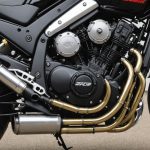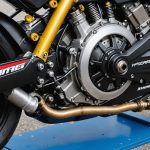Ultimate Guide to Effortlessly Installing a Hydraulic Clutch on Your Sports Bike for Smooth Riding in UK Traffic
Understanding the Importance of a Hydraulic Clutch
When it comes to enhancing the performance and riding experience of your sports bike, one of the most critical components to consider is the clutch system. A hydraulic clutch offers several advantages over traditional cable-operated clutches, including smoother engagement, reduced fatigue, and improved overall control. Here’s why you might want to make the switch:
- Smarter Engagement: Hydraulic clutches use fluid pressure to engage and disengage the clutch, which results in a more precise and consistent feel. This is particularly beneficial in heavy traffic or during long rides where constant shifting is necessary.
- Less Fatigue: Unlike cable clutches that can become stiff and require more effort over time, hydraulic clutches maintain a consistent feel, reducing rider fatigue.
- Better Control: The hydraulic system provides a more direct connection between the clutch lever and the clutch pack, giving you better control over your bike, especially at high speeds.
Preparing for the Installation
Before you dive into the installation process, it’s crucial to prepare your workspace and gather all the necessary tools and components.
Also read : Conquering uk emissions regulations: the complete handbook for sport bike compliance
Tools and Components Needed
- Hydraulic Clutch Kit: This typically includes the master cylinder, slave cylinder, hydraulic lines, and any necessary adapters.
- Bleeding Kit: To remove air from the hydraulic system.
- Torque Wrench: For securing bolts and nuts.
- Socket Set: For various bolts and fittings.
- Pliers and Wrenches: For handling hoses and fittings.
- Workstand or Lift: To elevate your bike for better access.
Workspace Preparation
- Ensure your workspace is clean and well-lit.
- Use a workstand or lift to elevate your bike, making it easier to access the necessary components.
- Lay out all your tools and components in an organized manner to avoid confusion during the installation.
Step-by-Step Installation Guide
Installing the Master Cylinder
The master cylinder is the component that converts the lever input into hydraulic pressure. Here’s how to install it:
- Remove the Old Clutch Lever:
- Take off the old clutch lever and any associated components like the cable and cable adjuster.
- Be careful not to damage any surrounding components.
- Mount the Master Cylinder:
- Locate the mounting point for the master cylinder, usually on the handlebar.
- Secure the master cylinder using the provided hardware. Make sure it is aligned properly and tightened securely.
- Connect the Hydraulic Lines:
- Attach the hydraulic lines to the master cylinder and ensure they are not kinked or damaged.
- Use the bleeding kit to fill the lines with hydraulic fluid.
Installing the Slave Cylinder
The slave cylinder is responsible for engaging and disengaging the clutch pack.
In parallel : Discover top gear to elevate your cycling experience online
- Locate the Clutch Pack:
- Find the clutch pack on your engine. This is usually located near the gear shift mechanism.
- Remove any protective covers to access the area.
- Mount the Slave Cylinder:
- Attach the slave cylinder to the engine block or transmission case, depending on your bike’s design.
- Ensure it is securely fastened with the correct torque specifications.
- Connect the Hydraulic Lines:
- Connect the hydraulic lines from the master cylinder to the slave cylinder.
- Make sure all connections are tight and not leaking.
Bleeding the Hydraulic System
Bleeding the system is crucial to remove any air that might have entered during the installation.
- Use a Bleeding Kit:
- Follow the instructions provided with the bleeding kit to fill the system with hydraulic fluid.
- Pump the clutch lever several times to circulate the fluid and remove any air bubbles.
- Check for Leaks:
- Inspect all connections for any signs of leakage.
- Test the clutch by engaging and disengaging it several times to ensure smooth operation.
Tips and Considerations for a Smooth Installation
Adjusting the Clutch Lever
- Adjust the Lever: Adjust the clutch lever to your preferred position. Make sure it is comfortable and easy to reach.
- Check the Free Play: Ensure there is the correct amount of free play in the lever to avoid premature wear on the clutch pack.
Ensuring Proper Riding Position
- Seat Height: Make sure the seat height is adjusted so that you can comfortably reach the ground with both feet.
- Handlebar Height: Adjust the handlebar height to ensure you are in a comfortable riding position, with your arms relaxed and your back straight.
Maintenance and Upkeep
- Regular Checks: Regularly check the hydraulic fluid level and top it off as necessary.
- Bleed the System: Bleed the system every few months or as recommended by the manufacturer to maintain optimal performance.
Comparing Hydraulic and Cable Clutches
Here is a detailed comparison between hydraulic and cable clutches to help you make an informed decision:
| Feature | Hydraulic Clutch | Cable Clutch |
|---|---|---|
| Engagement | Smoother, more precise | Can be stiff and inconsistent |
| Fatigue | Reduces rider fatigue | Can cause fatigue over long rides |
| Control | Better control, especially at high speeds | Less direct control |
| Maintenance | Requires periodic bleeding | Requires periodic cable adjustment |
| Cost | Generally more expensive | Generally less expensive |
| Complexity | More complex installation | Simpler installation |
Practical Insights and Actionable Advice
Mastering the Art of Shifting Gears
- Practice Makes Perfect: Practice shifting gears in a safe, controlled environment to get a feel for the new hydraulic clutch.
- Use the Correct Technique: Use the correct technique when shifting gears, ensuring you fully engage and disengage the clutch to avoid wear and tear.
Road Safety Tips
- Be Aware of Your Surroundings: Always be aware of your surroundings, especially in heavy traffic.
- Use Breakdown Cover: Consider investing in breakdown cover for peace of mind, especially on long rides.
Real-Life Examples and Anecdotes
A Rider’s Experience
“I recently upgraded my sports bike to a hydraulic clutch, and the difference is night and day. The smooth engagement and reduced fatigue have made long rides much more enjoyable. I no longer feel the strain in my hand and forearm after hours of riding,” says John, an avid motorcyclist.
Overcoming Common Challenges
One common challenge riders face is air in the hydraulic system. Here’s how to overcome it:
- “When I first installed my hydraulic clutch, I noticed it wasn’t engaging smoothly. After bleeding the system multiple times, I realized I had missed a small air bubble in one of the lines. Once I removed it, the clutch worked flawlessly,” shares Sarah, a motorcycle mechanic.
Installing a hydraulic clutch on your sports bike can significantly enhance your riding experience, especially in the dynamic traffic conditions of the UK. With the right tools, a bit of patience, and some practical advice, you can effortlessly upgrade your bike to enjoy smoother, more controlled rides.
Share Your Experience
If you’ve recently installed a hydraulic clutch or have any tips to share, feel free to comment below or share your story on social media using the hashtag #HydraulicClutchUpgrade.
By following this guide and taking the necessary precautions, you’ll be well on your way to mastering the art of smooth riding with your new hydraulic clutch. Happy riding











